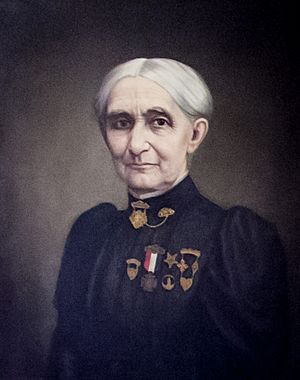Harriet Patience Dame facts for kids
Quick facts for kids
Harriet Patience Dame
|
|
|---|---|

Official portrait in the New Hampshire State House
|
|
| Born | 5 January 1815 Barnstead, New Hampshire, U.S.
|
| Died | 24 April 1900 (aged 85) |
| Occupation | Nurse |
| Years active | 1861-1865 |
| Known for | Civil War nurse |
Harriet Patience Dame (born January 5, 1815 – died April 24, 1900) was a very important nurse during the American Civil War. Her official painting is displayed in the New Hampshire State House. She was known for her bravery and dedication to helping soldiers.
Contents
Harriet's Early Life
Harriet Patience Dame was born in Barnstead, New Hampshire, on January 5, 1815. Her parents were James Chadbourne and Phebe Ayers. She was the youngest of five children in her family.
In 1843, Harriet moved to Concord, New Hampshire. She lived there until the Civil War began. Before the war, she worked at different jobs. By 1861, she was running a boarding house for students. It's interesting to know that she didn't have any special training as a nurse before the war started.
Serving in the Civil War
When the Civil War began, Harriet was 46 years old. She went to Camp Union in Concord, where new soldiers were training. She offered to help as a nurse. Since the camp didn't have a hospital, Harriet quickly started working as a nurse there.
Harriet served with the 2nd New Hampshire Volunteer Infantry. She worked as a matron, which is like a head nurse. She started in June 1861 and served until Christmas 1865. This was when the regiment finished its service. She never took a break during her time, serving through two periods of enlistment.
At first, her pay was six dollars a month. In 1863, it went up to ten dollars a month. The regiment was mostly made up of men from Concord and Exeter. Colonel Gilman Marston led them. Harriet often marched and camped with the troops. She was usually the only woman among about a thousand men.
Harriet's Hospital Duties
In September 1864, Harriet was made the matron of the 18th Army Corps hospital. Her job was to supervise other nurses. She also cooked for the many patients, sometimes thousands of them. Colonel Marston said she was the bravest woman he knew. He saw her face cannons without fear, even when men hid behind her. He said she was always there when she was needed most.
Harriet was present at several important battles. These included the First Battle of Bull Run, Second Battle of Bull Run, Battle of Fredericksburg, and Battle of Gettysburg. She did more than just medical care for the men. Sometimes, she would pick strawberries for the wounded soldiers. She also wrote letters home for them. Her nursing duties changed often. She might oversee supplies or check how clean other regiments' camps were. Harriet stayed at the hospital until the war ended. Then, she rejoined the 2nd New Hampshire Regiment. Her service officially ended on December 25, 1865.
Captured in Battle
Harriet was captured by the enemy twice during battles. But she was released both times. At the Second Battle of Bull Run, she was taken prisoner. However, she was set free because she cared for both Union and Confederate soldiers. In one case, General Stonewall Jackson even allowed her to return to the Union lines. This shows how respected she was.
Life After the War
After the Civil War, Harriet got a job in Washington, D.C. William E. Chandler appointed her to a clerkship in the Treasury Department. She worked there for twenty-eight years, until 1895. She did not return to her home state of New Hampshire until 1900.
In 1884, Congress voted to give her a military pension. This was money given to people who served in the military. However, Harriet always gave this money to people who needed help. She never married. Harriet died in Concord and was buried at Blossom Hill Cemetery.
Harriet also served as the third president of the National Association of Army Nurses of the Civil War. She took over after Dorothea Dix passed away and Dr. Susan Ann Edson resigned.
Honors and Recognition
Harriet Patience Dame received many honors for her amazing service:
- She was given special badges from different army groups. These included the cross of the 18th Corps, the diamond of the 3rd Corps, the heart of the 12th Corps, and a gold badge from the 2nd New Hampshire Regiment.
- Soon after the Civil War, the New Hampshire government gave Harriet $500. This was for her extraordinary public service. She gave most of this money to the 2nd Regiment. It was used to help start a home for veterans.
- When she died in 1900, Governor Frank W. Rollins and the state militia took part in her funeral. This showed how important she was to the state.
- In 1901, the New Hampshire Legislature asked for her portrait to be painted. It was then hung in the New Hampshire State House. This was the first painting of a woman to be displayed there.
- The Harriet P. Dame Elementary School in Concord was named in her honor.
- In 2002, Harriet Dame was inducted into the Hall of Fame by the American Nurses Association.


